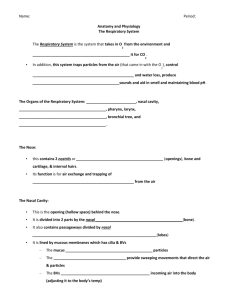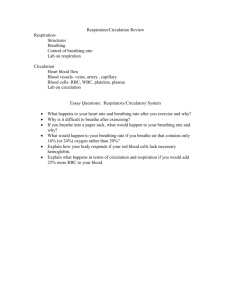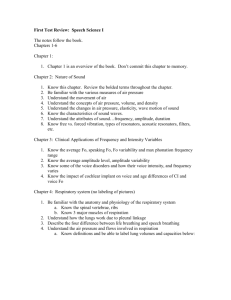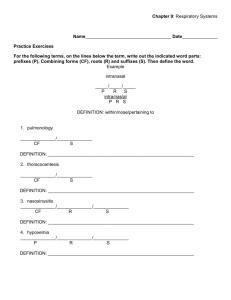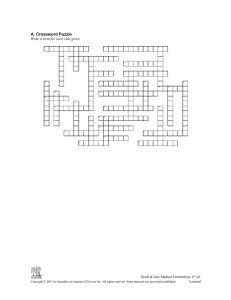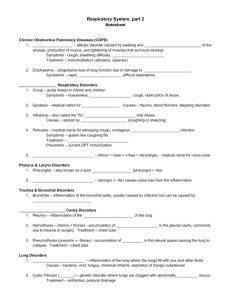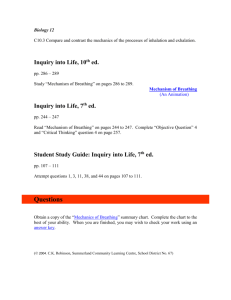MT Week 3
advertisement
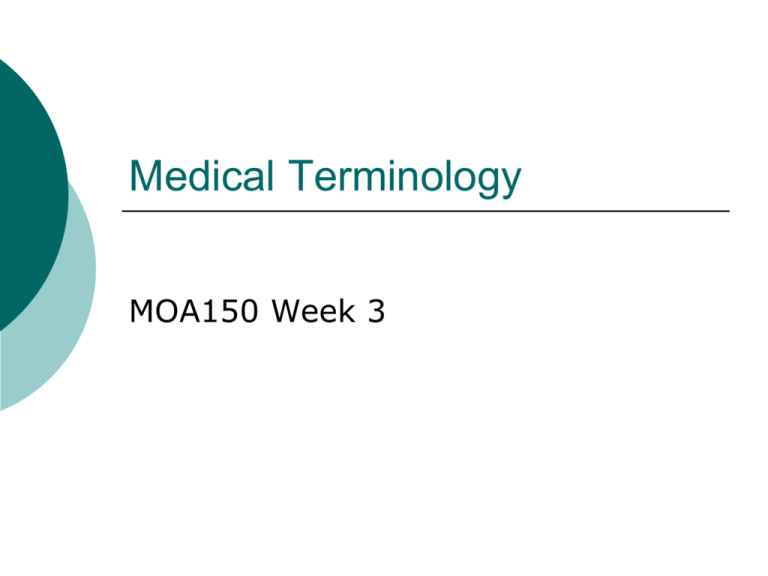
Medical Terminology MOA150 Week 3 Bronchitis bronch = bronchial tubes -itis = inflammation Inflammation of the bronchial walls Pleuritis pleur = side, rib -itis = inflammation Inflammation of the pleura that produces sharp chest pain with each breath Intercostal muscles inter = between cost = Ribs -al = characterized by Muscles which move the rib cage during breathing Bronchopneumonia broncho = bronchial pneumon= lungs -ia = condition Form of pneumonia that affects patches of the bronchioles throughout both lungs Eupnea eu = good, normal pnea = breathing Easy or normal breathing Tachypnea tachy = fast, rapid pnea = breathing Abnormally rapid rate of respiration Apnea a- = without, not pnea = breathing Absence of spontaneous respiration Dyspnea dys = difficult, painful pnea = breathing Difficult or labored breathing, commonly referred to as shortness of breath Cyanosis cyan = blue -osis = disease, condition of Bluish discoloration of the skin caused by a lack of adequate oxygen Pulse Oximeter oxi = oxygen meter = instrument of measurement External monitor that measures the oxygen saturation level in the blood Spirometry spiro = to breath meter = instrument of measurement Noninvasive test in which a patient breathes into a device to measure “breath” Antitussive anti = against, opposing tuss = coughing ive = performs Agent administered to prevent or relieve coughing Bronchodilator broncho = bronchial dilator = agent that widens or expands Agent that expands the opening of the passages to the lungs Tracheotomy trache = trachea otomy = incision, surgical cutting Procedure in which an incision is made into the trachea to gain access to the airway Tracheostomy trache = trachea ostomy = to make an opening Surgical formation of an opening into the trachea through the neck Cystic Fibrosis cyst = bladder, bag -ic = pertaining to fibr = connective tissue osis = disease Disorder of the exocrine glands marked by difficulty in breathing due to mucus accumulation in airways Anoxemia an = without ox = oxygen -emia = blood a condition of subnormal oxygenation of the arterial blood Anoxia an = without ox = oxygen -ia = condition Hypoxia especially of such severity as to result in permanent damage Hypoxemia hyp = decrease, below normal, defiency ox = oxygen -emia = blood Deficient oxygenation of the blood Laryngectomy laryng = larynx -ectomy = surgical removal surgical removal of all or part of the larynx Laryngoplegia laryngo = larynx -plegia = paralysis Paralysis of the larynx Dysphonia dys = painful phon = voice -ia = condition Defective use of the voice Hemothorax hemo = blood thorax = chest, pleural cavity Blood in the pleural cavity Hemoptysis hemo = blood ptysis = spitting Expectoration of blood from some part of the respiratory tract Pharyngitis pharyng = pharynx -itis = inflammation Inflammation of the throat or pharynx Pleurodynia pleuro = side, rib -dynia = pain sharp pain in the side usually located in the intercostal muscles Pulmonologist pulmon = lung -ologist = specialist a physician who specializes in the diseases and disorders of the lungs and respiratory system Hyperventilation hyper = excessive, overactive ventilation= process of exposing to air Abnormally rapid rate of deep respiration results in a change in blood gas levels due to decrease in carbon dioxide at the cellular level Bradypnea brady = fast, rapid pnea = breathing Abnormally slow rate of respiration Endotracheal endo = within trache = trachea -al = characterized by Placed within the trachea Polysomnography poly = many somno = sleep graphy = the process of recording technique or process of using a polygraph to make a continuous record during sleep of multiple physiological variables, such as respiration, heart rate and muscle activity Atelectasis a= without tele = distant, far ectasis = stretching, enlargement, dilation Collapse of an expanded lung, usually due to air passages being blocked or by shallow breathing

